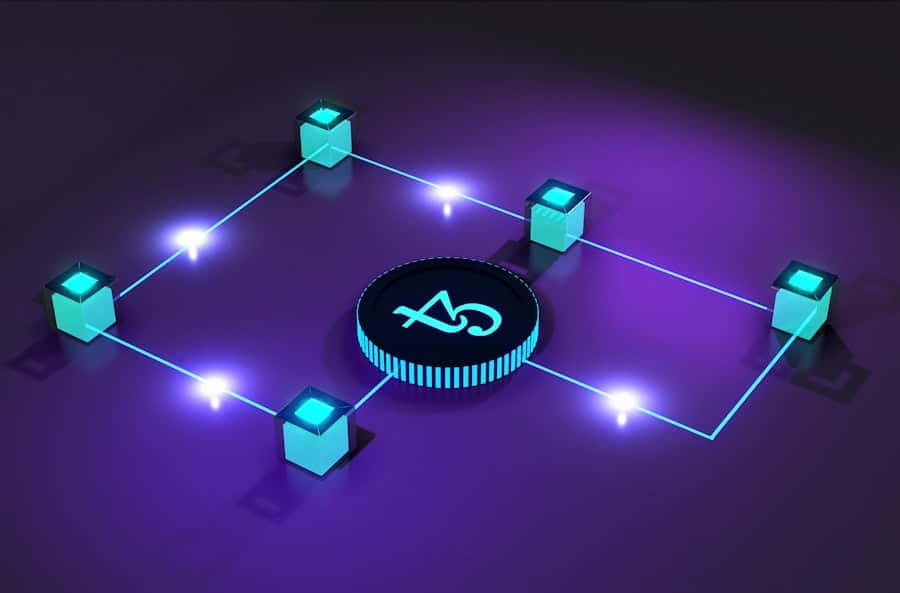Blockchain technology is a decentralized digital ledger system that records transactions across multiple computers in such a way that the registered transactions cannot be altered retroactively. This technology operates on a peer-to-peer network, where each participant, or node, has access to the entire database and its transaction history. The decentralized nature of blockchain ensures that no single entity has control over the entire chain, which enhances security and transparency.
Each block in the chain contains a list of transactions, a timestamp, and a cryptographic hash of the previous block, creating an immutable record that is resistant to tampering. The significance of blockchain extends beyond cryptocurrencies like Bitcoin; it has the potential to revolutionize various sectors, including finance, supply chain management, and intellectual property.
This trust is particularly crucial in industries where authenticity and provenance are paramount, such as art, music, and literature. As blockchain technology continues to evolve, its applications in managing and protecting intellectual property rights are becoming increasingly relevant.
Key Takeaways
- Blockchain is a decentralized, distributed ledger technology that securely records transactions across multiple computers.
- Blockchain has the potential to revolutionize copyright laws by providing a transparent and immutable record of ownership and rights.
- Intellectual property can be protected on the blockchain through the use of smart contracts and digital signatures.
- Copyright holders face challenges in enforcing their rights on the blockchain, but also have opportunities to streamline licensing and royalty payments.
- Blockchain can enhance digital rights management by providing a secure and transparent platform for managing and protecting digital content.
The Impact of Blockchain on Copyright Laws
The advent of blockchain technology poses significant implications for copyright laws, which have traditionally struggled to keep pace with the rapid evolution of digital content distribution. Copyright law is designed to protect the rights of creators by granting them exclusive rights to their works, but the digital age has introduced complexities such as piracy, unauthorized distribution, and the ease of copying content. Blockchain offers a potential solution by providing a transparent and verifiable method for tracking ownership and usage rights of creative works.
One of the most profound impacts of blockchain on copyright laws is the ability to create a permanent and tamper-proof record of ownership. By registering a work on a blockchain, creators can establish proof of authorship that is easily verifiable by others. This could significantly reduce disputes over ownership and help creators assert their rights more effectively.
Furthermore, smart contracts—self-executing contracts with the terms of the agreement directly written into code—can automate licensing agreements and royalty payments, ensuring that creators are compensated fairly for their work without the need for intermediaries.
Protecting Intellectual Property on the Blockchain
Protecting intellectual property (IP) on the blockchain involves leveraging its unique features to safeguard creators’ rights and ensure that their works are not misappropriated. One of the primary methods for doing this is through tokenization, where digital assets are represented as tokens on a blockchain. These tokens can encapsulate various rights associated with a work, such as reproduction rights, distribution rights, and performance rights.
By tokenizing their works, creators can maintain control over how their content is used and monetized. Moreover, blockchain technology enables creators to set specific terms for how their works can be utilized through smart contracts. For instance, a musician could issue a token representing their song that includes conditions for streaming or downloading.
When someone wants to use the song, they would interact with the smart contract, which would automatically execute the agreed-upon terms—such as payment of royalties—without requiring any manual intervention. This not only streamlines the process but also ensures that creators receive timely compensation for their work.
Challenges and Opportunities for Copyright Holders
While blockchain presents numerous opportunities for copyright holders, it also introduces several challenges that must be addressed.
Many jurisdictions still rely on conventional methods of registration and documentation, which may not fully acknowledge or understand blockchain’s capabilities.
This discrepancy can create confusion and hinder the adoption of blockchain solutions among creators who are wary of potential legal complications. Another challenge lies in the technical complexities associated with implementing blockchain solutions for copyright management. Many creators may lack the technical expertise required to navigate blockchain platforms or understand how to effectively tokenize their works.
Additionally, there is a risk that the proliferation of blockchain-based IP management systems could lead to fragmentation within the industry, making it difficult for creators to manage their rights across multiple platforms. Despite these challenges, the opportunities presented by blockchain—such as enhanced transparency, reduced piracy, and improved royalty distribution—are driving interest in exploring its potential within copyright law.
Blockchain and Digital Rights Management
Digital Rights Management (DRM) has long been a contentious issue in the realm of copyright protection. Traditional DRM systems often impose restrictions on how users can access or share digital content, leading to frustration among consumers and challenges for creators trying to balance accessibility with protection. Blockchain technology offers an innovative approach to DRM by enabling more flexible and user-friendly solutions that respect both creators’ rights and consumers’ needs.
By utilizing blockchain for DRM, creators can establish clear usage rights while allowing consumers to engage with their content in meaningful ways. For example, a filmmaker could use blockchain to grant specific viewing rights to different audiences—such as allowing early access to backers while restricting general public access until a later date. This level of granularity in rights management can enhance consumer engagement while ensuring that creators retain control over their works.
Furthermore, because blockchain provides an immutable record of transactions, it can help deter piracy by making it easier to trace unauthorized use back to its source.
Legal Implications of Blockchain in Copyright Law
The integration of blockchain technology into copyright law raises several legal implications that warrant careful consideration. One primary concern is the question of jurisdiction; as blockchain operates on a global scale without regard for national borders, determining which laws apply in cases of copyright infringement can become complex. Different countries have varying copyright laws and enforcement mechanisms, which could lead to conflicts when dealing with cross-border disputes involving blockchain-registered works.
Additionally, there is the issue of compliance with existing copyright frameworks. While blockchain can enhance transparency and efficiency in managing IP rights, it must still operate within the confines of established legal systems. This means that any blockchain-based solution must be designed with an understanding of existing copyright laws to ensure that it does not inadvertently violate them.
As lawmakers begin to grapple with these challenges, there may be a need for new regulations or amendments to existing laws that specifically address the unique characteristics of blockchain technology.
Case Studies of Blockchain in Intellectual Property
Several pioneering projects have emerged that illustrate the practical applications of blockchain technology in intellectual property management. One notable example is Ascribe, a platform that allows artists to register their works on a blockchain, providing them with proof of ownership and enabling them to license their creations directly to consumers. Ascribe’s approach empowers artists by giving them greater control over their works while simplifying the licensing process.
Another significant case study is Myco’s use of blockchain for music rights management. Myco has developed a platform that allows musicians to register their songs on a blockchain while automatically generating smart contracts for licensing agreements. This system not only streamlines royalty payments but also provides transparency regarding how songs are used across various platforms.
By leveraging blockchain technology, Myco aims to address longstanding issues within the music industry related to fair compensation and rights management.
The Future of Copyright Laws in the Age of Blockchain
As blockchain technology continues to mature, its influence on copyright laws is likely to grow more pronounced. The potential for increased transparency and efficiency in managing intellectual property rights could lead to significant reforms in how copyright law is structured and enforced. Lawmakers may begin to recognize the need for new frameworks that accommodate the unique characteristics of blockchain while ensuring that creators’ rights are protected.
Moreover, as more creators adopt blockchain solutions for managing their works, there may be a cultural shift toward valuing transparency and direct engagement between creators and consumers. This shift could foster an environment where creators feel empowered to experiment with new business models and distribution methods without fear of losing control over their intellectual property. Ultimately, the intersection of blockchain technology and copyright law presents both challenges and opportunities that will shape the future landscape of intellectual property management in profound ways.
Blockchain technology is revolutionizing the way intellectual property rights are managed and enforced, particularly in the realm of copyright laws. One related article that delves into the intersection of blockchain and intellectual property is “Huawei Mate 50 Pro: A Game-Changer in the Smartphone Industry”. This article explores how Huawei’s latest smartphone is incorporating blockchain technology to enhance security and protect intellectual property rights. By leveraging blockchain, companies like Huawei are able to ensure the authenticity and ownership of digital content, ultimately reshaping the landscape of copyright laws.
FAQs
What is blockchain technology?
Blockchain technology is a decentralized, distributed ledger system that records transactions across many computers in such a way that the registered transactions cannot be altered retroactively. It is the technology behind cryptocurrencies like Bitcoin and has potential applications in various industries beyond finance.
How is blockchain technology changing copyright laws?
Blockchain technology is changing copyright laws by providing a secure and transparent way to record and manage intellectual property rights. It allows for the creation of immutable records of ownership and provenance, making it easier to enforce copyright laws and protect the rights of creators.
What are the benefits of using blockchain for intellectual property rights?
Using blockchain for intellectual property rights offers several benefits, including increased transparency, reduced risk of fraud or infringement, and improved efficiency in managing and enforcing copyright laws. It also provides a secure and tamper-proof way to record and track ownership of creative works.
How does blockchain technology help in the protection of intellectual property?
Blockchain technology helps in the protection of intellectual property by creating a permanent and tamper-proof record of ownership and transactions. This can help in proving the originality and ownership of creative works, as well as in enforcing copyright laws and preventing unauthorized use or infringement.
What are some examples of blockchain applications in intellectual property rights?
Some examples of blockchain applications in intellectual property rights include platforms for registering and managing copyrights, digital rights management systems, and marketplaces for buying and selling digital content with built-in copyright protection. These applications leverage blockchain’s capabilities to provide secure and transparent management of intellectual property rights.



